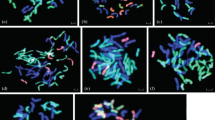Summary
The diploid and tetraploid wheats have a crossing barrier that inhibits development and viability of the F1 hybrid seeds which result from their pollination with rye. This barrier is ineffective in synthetic or natural hexaploid wheat × rye crosses. From the results obtained by crossing the Chinese Spring monosomic series to a diploid rye composite, it was concluded that the breakdown of this barrier in hexaploid wheats is determined by polygenes, but may also involve genedosage effects. While more than half of the hexaploidwheat chromosomes may contribute to the breakdown of the barrier, chromosome 1D had the strongest effect. Its absence resulted in shrivelled and inviable hybrid kernels similar to those obtained when the T. durum cultivar Langdon was crossed with rye.
Similar content being viewed by others
References
Briggs FN, Knowles PF (1967) Introduction to plant breeding. Reinhold Publ Corp, New York
Brink RA, Cooper DC (1940) Double fertilization and development of the seed in angiosperms. Bot Gaz 102:1–25
Brink RA, Cooper DC (1947) The endosperm in seed development. Bot Rev 13:423–541
Jalani BS, Moss JP (1980) The site of action of the crossability genes (Kr1, Kr2) between Triticum and Secale. I. Pollen germination, pollen tube growth, and number of pollen tubes. Euphytica 29:571–579
Johnston SA, Den Nijs TPM, Peloquin SJ, Hanneman RE (1980) The significance of genic balance to endosperm development in interspecific crosses. Theor Appl Genet 57:5–9
Joppa LR (1985) Personal communication. North Dakota State University, Fargo, North Dakota
Kerber ER, Rowland GG (1974) Origin of the free threshing character in hexaploid wheat. Can J Genet Cytol 16:145–154
Keyworth S, Larter EN (1979) Embryo and endosperm development in wheat-rye hybrids. Cereal Res Commun 7:135–143
Krolow KD (1964) Kreuzungen zwischen tetraploiden Weizen der Emmerreihe und 4n- bzw. 2n-Roggen in Verbindung mit Embryotransplantationen. Z Pflanzenzücht 51:21–46
Krolow KD (1970) Untersuchungen über die Kreuzbarkeit zwischen Weizen und Roggen. Z Pflanzenzücht 64:44–72
Krolow KD (1973) 4x-Triticale, production and use in triticale breeding. Proc 4th Int Wheat Genet Symp, Columbia, Mo, pp 237–243
Lein A (1943) Die genetische Grundlage der Kreuzbarkeit zwischen Weizen und Roggen. Z Indukt Abstamm Vererbungsl 81:28–61
Marais GF, Pienaar R de V (1977) Hybridization between wheat and rye. II. Variations in the germinability of the hybrid kernels with special reference to the effect of the D-genome. Agroplantae 9:143–148
Morris R, Sears ER (1967) The cytogenetics of wheat and its relatives. In: Quisenberry KS, Reitz LP (eds) Wheat and wheat improvement. Am Soc Agron, Madison, Wis, pp 19–87
Nakajima G (1955) A cytogenetical study on the intergeneric F1-hybrid between Triticum polonicum and Secale africanum. Cytologia 20:273–279
Nishiyama I, Yabuno T (1978) Causal relationships between the polar nuclei in double fertilization and interspecific cross-incompatibility in Avena. Cytologia 43:453–466
Pienaar R De V (1985) Annual report. Dept of Genetics, University of Stellenbosch, Stellenbosch, South Africa
Pienaar R De V, Marais GF (1986) Effect of D-genome chromosome substitutions on hybrid seed development and viability in T. turgidum var durum × S. cereale crosses. J Plant Breed 97:112–118
Riley R, Chapman V (1967) The inheritance in wheat of crossability with rye. Genet Res 9:259–267
Sears ER (1953) Nullisomic analysis in common wheat. Am Nat 87:245–252
Snedecor GW, Cochran WG (1967) Statistical methods. Iowa State University Press, Iowa
Tsunewaki K (1963) The transmission of the monosomic condition in a wheat variety, Chinese Spring. II. A critical analysis of nine year records. Jpn J Genet 38:270–281
Wojciekowska B, Lange W (1977) The crossing of common wheat (Triticum aestivum L) with cultivated rye (Secale cereale L). II. Fertilization and early post-fertilization developments. Euphytica 26:287–297
Author information
Authors and Affiliations
Additional information
Communicated by K. Tsunewaki
Rights and permissions
About this article
Cite this article
Marais, G.F., van der Westhuizen, M.S.S. Hybrid seed development and viability in crosses of T. aestivum (cv. Chinese Spring) monosomic lines with S. cereale . Theoret. Appl. Genetics 74, 503–507 (1987). https://doi.org/10.1007/BF00289829
Received:
Accepted:
Issue Date:
DOI: https://doi.org/10.1007/BF00289829



